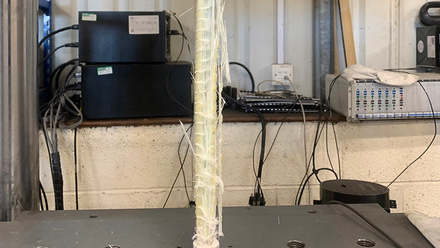An insight into policies and strategies for COP26 and beyond
As the UK prepares to lead discussions on climate change strategies among world leaders next month, Shardell Joseph reports from an event that navigated the 'Next steps for UK climate change policy and priorities for COP26'.

‘By 2020, after the Paris Agreement five years ago, principally global carbon emissions fell by 7% [related to COVID-19]. However, this year, there are forecasts that we will add carbon emissions, reaching the second fastest rate in history,’ heeded Lord Daniel Brennan QC and Vice Chair of the Westminster All-Party Parliamentary Group on Microplastics.
Lord Brennan's warning came at a Westminster Forum policy conference that discussed goals and ambitions ahead of the 26th UN Climate Change Conference (COP26) in Glasgow, UK, in November.
Chris Stark, Chief Executive of the UK Committee on Climate Change, asserted the leading role the UK will play as host of the event. ‘The eyes of the world will be on us when we consider what that policy challenge needs to look like. The biggest challenge we see in achieving net-zero is [the] issue of managing asset turnover. And we can point out now to the government, the dates by which we need to phase out the sale of those high-carbon assets.’
Assessing whether COP26 can be a success and how to make it a success, Shaun Spiers, Executive Director of Green Alliance, UK, presented sentiments regarding the government’s role as host. ‘On the positive side, it's great that…we are hosting it and [that] the government is keen…The government's ambitions for climate action [are] genuinely ambitious world-leading targets and really brave.
‘[However], I have two massive concerns about the UK’s ability to oversee a successful conference in November. And we've got very little time to sort them out. The first is the government's record on emissions reduction – not as aims, but actions – because it's great to have world-leading targets, but you do need to have a credible plan for delivering them.
‘And although there have been lots of good things, on electric vehicles for instance, there's a lack of concerted effort across all government departments. And some ministers…are not only doing too little, but some are also resisting necessary action.’
Alyssa Gilbert, who is Chair of the COP26 Universities Network and Director of Policy and Translation at the Grantham Institute for Climate Change and the Environment, at Imperial College London, UK, added, ‘What we can see now is that after 26 years, you need to translate these high-level strategic targets into real action on the ground.
‘We need to demonstrate what it means to have joined-up policy and strategic approaches. And then that puts us in a position to have those discussions with other governments.’
Bringing together attendees from local and national government, industry, the energy, agriculture and environment sectors, as well as legal and technical institutions, the event explored the different priorities for national and international strategies towards net-zero.
The power of electrification
David Acres, Head of Policy at EDF Energy, reflected on the role of low-carbon electricity supply in enabling other sectors to decarbonise.
He outlined that the carbon intensity of electricity generation in the UK is approximately 220g of CO₂p/kWh, with projections showing a reduction to 50 in 2030, to 10 in 2035 and, ultimately, two in 2050.
‘The key figure there…is the 10, because that means electricity is effectively decarbonised by 2035. And that's delivered by increasing variable renewable generation to about 70% of generation by 2035 and 80% by 2050.
‘I think the key message from this is that net-zero delivery is being front-loaded in the electricity sector, in the UK, but actually also globally. And in a COP26 context, that's…one of the ways that the UK can demonstrate practical, affordable steps to decarbonisation to other countries [and] actually work with those other countries that are already at the forefront of renewables development, to maintain that momentum and increase the cost reductions that we've seen.’
Acres stated that to meet demand, electricity generation schemes will need to double or even triple by 2035, rolling out proposed solutions into other sectors.
‘That combination of increasing demand and the simultaneous decarbonisation means that we need low-carbon generation to quadruple by 2050 from where we are. That's very challenging, but it is affordable, because low-carbon electricity can now be produced more cheaply than the high-carbon alternatives, certainly in the UK, and globally.’
Acres highlighted how levels of investment, unprecedented in terms of new generation, will be needed to meet these demands. ‘That scale is far away over developers’ and the operators’ balance sheets. So, what we are going to need is a very wide range of financing sources for that. And we need to access the lowest cost of capital…Investment propositions that we're putting to these investors, and the design of future policy but also future markets, need to take account of that investors’ perspective.
‘We [also] need stability and predictability. To continue with high levels of investment in low-carbon technologies…we do need to move as technologies and markets change. But we need a maximum amount of notice for that. So, we are going to have to look at how to support these low-carbon technologies, we need to have a look at how they interface with the wholesale and retail markets, electricity, or indeed interface with other sectors.’
Risk and reward
Neil Brown, Chief Risk Officer at Earth Capital in London, UK, said investors note the importance of realistic ambitions around transitioning away from energy-intensive sectors, and they should be rewarded for the risks they are taking.
‘We are in the business of making money for our investors. So, what makes this affordable...or what's the right public/private funding mix. There's generally got to be a better assessment of the costs and benefits of actions and inactions...The longer we prevaricate, the more the cost will be.’
To increase investment towards net-zero, he hypothesised, ‘we need to generate returns for now, but also for the future…I'm not talking about wild, excessive super profits in any shape or form, but a steady return structure that allows us to push money back to our investors, [and] to encourage them into what they still see as potentially some risky type of assets. And by doing that, [it] will help to oil the wheels that move towards a circular economy or a low-carbon economy.’
Brown considered building on strategies like the Taskforce for Climate related Financial Disclosure, which gives recommendations to stakeholders to understand better the concentrations of carbon-related assets in the financial sector. ‘[It] is being applied to corporates and to asset managers and to asset owners, talking about the impact of either physical or transition risks from climate change on assets or investments or companies or portfolios. And that kind of self-assessment and increasing transparency is actually core to understanding the risks that we're taking.’
A local approach
In July this year, the UK’s National Audit Office released a report, Local government and net zero in England, outlining the critical role of local authorities in contributing to the UK’s statutory net-zero target. The document asserted that central government needs to improve its approach to working with local authorities on decarbonisation.
Paula Hewitt, Deputy Chief Executive, Lead Director for Economic and Community Infrastructure, and Director of Commissioning at Somerset County Council, UK, expanded on the report by showcasing how local authorities can help influence policy, test ideas and often pilot initiatives.
‘I believe local authorities are absolutely key partners in climate action. Climate change was a top priority for local authorities well before COVID-19, and many had declared climate emergencies. And already most councils have developed local climate action plans. I think it's really important to see local authorities developing those plans [and] recognise the need to address adaptation alongside mitigation.’
Hewitt acknowledged the value in creating a wider network of local communities to deliver carbon-reduction benefits, as well as health outcomes, environmental improvements and nature-based solutions for flooding.
‘We've recognised that collaboration is really key to what we do. Each council on their own can only have a very small impact. So, we collaborate as local authorities with a wide range of partners, both local and national within the sector and beyond, including volunteer organisations and academia.’
Hewitt explained how back in 2019, five Somerset local authorities each recognised and declared a climate emergency and went on to produce a local climate emergency plan, identifying some ways in which the county could become carbon neutral by 2030.
‘It was developed with input from academic and industry subject matter experts, and comprehensive consultation exercises shaped that strategy. I think that was really important. It made sure the strategy reflected local input, local people's priorities and was owned by the people of Somerset.
‘A joined-up approach by all agencies – both central and local – is needed if the challenges in rural areas are to be overcome, aligning timescales for action and…ambitions for aligning funding stream timescales,’ she urged.
Collaborating for climate recourse
A growing group of UK-based universities and research centres are cooperating to raise the ambition for tangible outcomes from COP26. With around 80 universities and research centres involved, the aim of the COP26 Universities Network is to contribute research, training, translation and innovation to collectively tackle climate change.
“[What we have been] trying to do for the past year is pull together, in a collaborative way, all of the different centres of research excellence, all types of researchers around the world who have access to evidence on what we can be doing about climate change, and the impact mitigation and adaptation actions,” said Alyssa Gilbert, Chair of the COP26 Universities Network, and Director of Policy and Translation at the Grantham Institute for Climate Change and the Environment at Imperial College London.
The network focuses on the research and the evidence, sharing it with policymakers. “We also have really vital connections to students in our own communities, and building ways that we can engage with COP itself. But afterwards, we can be part of delivering the legacy from COP26 and continue to strive for action,” Gilbert explained.
Making net-zero accessible
Co-chairing the event, Baroness Sandip Verma, Non-Executive Director of the UK Renewable Energy Association, outlined additional factors that need to be considered so that net-zero goals are accessible globally.
She noted that there will be even more migration from poorer countries to other nations ‘which will constantly be disruptive to how the world balances itself into responding proactively to what needs to be done within those poor countries.
‘I hope that COP26 really does have an impact on looking at how it addresses the impact on women, the impact on girls, the impact on the poorest countries, as well as how we, in the wealthier nations, are able to share best practice, and develop systems that not only help the rich, developed nations, but really do reach out to the very poorest of the poor on the planet’.







